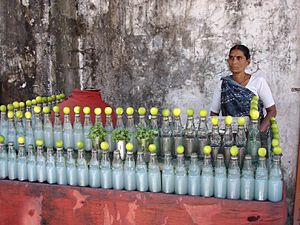Banta facts for kids

A lemonade seller with Banta soda bottles, Rishikesh, India.
|
|
| Course | Beverage |
|---|---|
| Place of origin | Indian subcontinent |
| Associated national cuisine | India |
| Serving temperature | Chilled |
Banta Soda, also known as Banta or Goli Soda, is a super popular fizzy drink in India. It's been around since the late 1800s! This cool drink comes in a special bottle called a Codd-neck bottle. It's usually lemon or orange flavored.
What makes the bottle special? It has a glass marble inside! This marble acts like a cap. The fizzy gas inside pushes the marble up. It seals the bottle tightly against a rubber ring. To open it, you press the marble down. This releases the gas with a fun pop!
You can easily find Banta Soda from street sellers. They are called bantawallahs. The drink is quite affordable. It's often served in glass cups. Sometimes, it's mixed with lemon juice, crushed ice, and special spices. These spices include chaat masala and kala namak (black salt). This makes it taste like a fizzy version of traditional lemonades such as shikanjvi or jal-jeera.
Banta Soda is very popular in places like Delhi, Punjab, and Uttar Pradesh. In Tamil Nadu and Andhra Pradesh, a version called Panneer Soda is popular. It has a lovely rose scent. People in Delhi often call Banta Soda "Delhi's local drink." It's a big hit in Old Delhi and around Delhi University campuses. Some sellers, like Pandit Ved Prakash Lemon Wale in Chandni Chowk, have been selling it since the 1870s!
Because it's so loved, you can even find Banta Soda in fancy restaurants and cafes now. Big companies also make their own versions with different flavors.
Contents
All About Banta Soda

What's in a Name?
The name "Banta" comes from the marble inside the bottle. In Hindi and Punjabi, a marble is called banta, goli, or goti. That's why it's known as Banta Soda or Goti Soda in North India. In South India, it's called Goli Soda. In Delhi, some people also call it the kanchay waali drink (the marble drink) or nimbu soda. In Bengali, it's known as Fotash Jawl.
A Look Back in Time
The special Codd-neck bottle was invented by Hiram Codd in 1872. He designed it just for fizzy drinks. These bottles became very popular across the British Empire. Today, they are mainly made in only two countries: India for Banta Soda and Japan for a drink called ramune.
Did you know that old Codd-neck bottles are collector's items? Kids used to break them to get the marble inside! Before the 1900s, India imported these bottles from Britain. Before India became independent in 1947, these bottles were sometimes used in unexpected ways, leading to them being banned in some cities. In the 1950s, Banta Soda was even sold from horse-drawn carts! These carts also carried the equipment to make the soda.
How Banta Soda is Made
Making Banta Soda is a cool process!
- First, ingredients like salt and water are mixed with flavors. These flavors can come from fresh fruit juice or special commercial flavors.
- This mixture is poured into the Codd-neck bottle using a funnel.
- The bottle is then placed into a special soda-making machine.
- A nozzle from the machine seals the bottle's mouth. It then pumps in carbon dioxide gas.
- The machine rotates the bottle a few times. This helps the gas mix well.
- The gas pressure pushes the marble up. It seals the bottle tightly against the rubber ring at the top.
- Banta Soda bottles are reusable! After you finish your drink, the bottlers collect them. They clean, wash, and sanitize the bottles. Then, they fill them up again!
Banta Soda Today
Just like ramune in Japan, Banta Soda in India still uses the unique Codd-neck bottle. This heavy glass bottle has a marble that seals it using the pressure of the fizzy drink. This special bottle is why the drink is also called goli soda in South India.
Bottle Makers
Before India became independent, the Codd-neck bottles were imported from England. After independence, local factories started making them. Now, only one company in India, Khandelwal Glass Works in Sasni, Uttar Pradesh, makes these bottles. They've been doing it since 1981!
In the early 1990s, Banta Soda sales were at their highest. This was before big soft drink brands like Pepsi and Coca-Cola returned to India in 1993. Sales have dropped since then, but Banta Soda is still loved.
Bottling Units
Many small, local businesses bottle Banta Soda. These "single-room bottling units" sell bottles for a very low price. In 2017, Delhi had over 100 such units!
Some new companies are now making Banta Soda in a more organized way. For example, Kozzmo Beverages in Chennai started in 2018. They make commercial, pre-packaged goli soda in a clean factory. They offer six flavors, including paneer soda, lemon, and orange.
Another company, Spark Premium Codd Soda, started making a premium goli soda in Telangana in 2019. The founder, Mohammed Abdul Khader, says that new machines have made it easier to produce goli soda again. This has helped it make a comeback!

